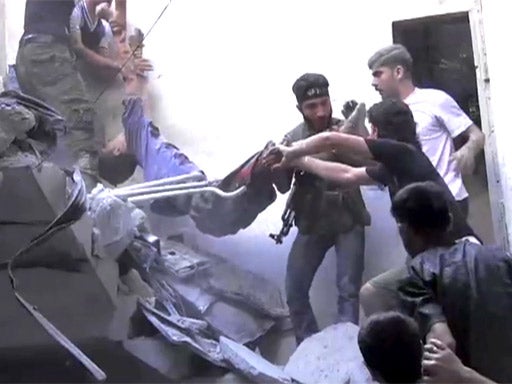Syria: Five children killed by air strike in Bustan al-Qasar as Assad regime steps up bombardment of Aleppo

The air strike, on a bright sunny afternoon, was on a residential area. The missile tore through the home of the Quoreyas on Mohammed Nadeem Street, collapsing the top floors on the ones below, obliterating the hastily dug shelter in the basement and starting a fire which spread swiftly.
Seven members of the family were killed, five of them children. Yusuf, Taharid and Bara were together at the time. They were, respectively, an 18 months old boy and seven and eight year old girls. Hatem, 15, was another one to die; the dismembered remains of 14 year old Mahmoud was found alongside those of those of his mother, Waheeda, blown to the roof of the house next door.
The Mig-23 had already hit another house in the Bustan al-Qasar subrurb of Aleppo. It took it’s time before launching the next salvo, flying low seemingly to fix on the target. It may have been aiming at a base used by rebel fighters not far away or it may have been seeking a building which had seen a number of vehicles come and go, a field hospital which did not advertise itself because others had come under attack.
When the body of the Abdul Latif Quoreya, the father of the family, was found, there was still hope that some of the others at home may have survived. Relations, neighbours and friends scrabbled through the debris with shovels, pick-axes, their bare hands as others from the street fled around them in panic and the regime’s warplane continued to circle overhead.
The scale of the carnage soon made it apparent that the effort was in vain. “We did everything we could, the stairway was falling, there was burning everywhere, but we went up to all the rooms but no one was left alive” said Marouf, a 26 year old cousin of the lost children. “I was crying when I was doing this, it was so hard thinking about what had happened, especially to the little ones. Our grandmother is sick with sadness, she wanted to come here to see what has happened, but she would not have recovered if she had seen this.
“We thought that because we were away from where the battles were taking place, we were safe, but with the airplanes you cannot be safe anywhere in this city.” Marouf continued as he and three other cousins put body parts of their relations into a burlap sack for burial.
There are no attempts any longer to hide the fact that Basher al-Assad’s regime was using modern warplanes to bomb its own citizens. It has, instead, become a tool of intimidation and state terror. Late this morning another Mig swooped down lower than it would have needed to fire off its missiles, confident that it faced no threat from the ground, before banking leisurely and flying away. Fifteen minutes later a helicopter appeared on the same patch of sky along with the rasping, and increasingly familiar, sound of its’ machine-guns in action.
The use of aircraft is undoubtedly having a psychological effect upon the beleaguered population of Aleppo. People look anxiously above as they gather on the pavements, they run to cross roads, and some have decided that the threat is too much to endure. Bustan al-Qasar, an unremarkable neighbourhood, had a population of 300,000. It is now down to around 40,000 with a rise in the exodus in the last few days.
“The Migs and the helicopters is the reason we are leaving” said 49 year old Hussein Ali Abdu, as he gathered his wife and five children into an ancient Toyota and tied bundles on to a roof rack. “I have not heard of Basher using his planes so much anywhere else in Syria. But he wants to punish us here in Aleppo because he thought this was one of the places which would never dare to rise against him. But why is he using is against civilians, his fight is with the Shabaab (rebel fighters).”
Mr Abdu’s brother, who is staying behind, nodded: “Why aren’t the Shabaab protecting us against the planes? They say they have rockets to shoot them down, where are they?”
Some rebels continue to insist that they do, indeed, have surface to air missiles in their arsenal. “We have got them through Turkey, we shall use them at the right time, there will be a shock for the regime, they will be very afraid” declared ‘Captain’ Ali Syed Naimuddin. But around him, at the base near where the air strikes had taken place, the rebel fighters did not look particularly confident when discussing their anti-aircraft strategy. The look of unease increased as a warplane appeared overhead soon afterwards and dropped ordnance nearby.
It is the medics, working in secret, under extremely difficult conditions, who are having to cope with the aftermath of the air strikes. Hadil Ami, a young female doctor, was on duty at a newly set up clinic when the victims from the Quoreya family were brought in. “The worse thing is that we may have been able to save the little boy if we had the right equipment, he had head injuries, but we could have saved him” she said quietly. “I took a picture of him before they took him away, I looked at it later and felt so helpless and so angry.”
Join our commenting forum
Join thought-provoking conversations, follow other Independent readers and see their replies
Comments
Bookmark popover
Removed from bookmarks